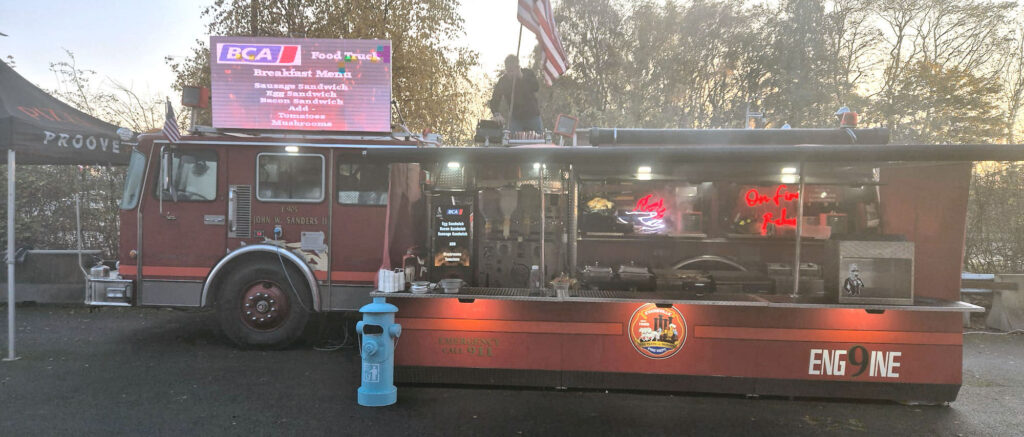French street food is a culinary adventure. It’s a vibrant blend of tradition and innovation, served up on bustling streets and charming squares.
This gastronomic journey is not just about satisfying hunger. It’s about experiencing the rich tapestry of French culture, one bite at a time.
From the humble baguette sandwich to the gourmet offerings of modern food trucks, French street food is diverse. It reflects the regional flavors and culinary heritage of this beautiful country.
But it’s not just for foodies and travelers. Marketing managers can find inspiration in the creativity and originality of French street food. It’s a unique content idea that resonates with audiences.
Wedding planners, too, can tap into the allure of French street food. Imagine a food truck serving up delicious crepes or croque monsieur at a wedding. It’s a wow factor that guests will remember.
In this guide, we’ll explore the best of French street food. We’ll delve into its history, its iconic dishes, and its role in French culture.
Join us on this culinary journey. Discover the charm of French street food and how it can inspire your work and enrich your experiences.

The Allure of French Street Food
French street food captivates with its fusion of simplicity and sophistication. It’s a testament to the country’s culinary expertise, distilled into quick, savory bites. These delights invite curious palates to experience traditional flavors and modern twists.
The streets of France transform into open-air food markets, where vendors share their creations. Each stall offers a unique culinary perspective, turning every corner into an opportunity for new tastes. From bustling Paris streets to quaint provincial towns, the allure of French street food is undeniable.
For anyone seeking authenticity, French street food provides a genuine taste of local life. It reflects the social and cultural heartbeat of communities. The interactions at food stalls create a lively atmosphere, blending everyday life with gastronomic pleasure. Embrace the authenticity and charm of French street food, where each bite tells a story of tradition and innovation.
A Bite into History: The Origins of French Street Food
The origins of French street food are rooted in the Middle Ages. Markets and fairs were bustling, vibrant scenes filled with food sellers. These vendors offered convenience with simple, hearty meals to travelers and locals alike.
As cities grew, so did the popularity of street food in France. Urbanization during the industrial revolution saw people leading faster-paced lives. Street food became an essential part of daily sustenance, offering nourishment quickly without sacrificing flavor.
This culinary tradition was influenced by diverse cultures and trade routes. Each region adopted and adapted ingredients, creating distinct local fare. French street food is a rich tapestry, weaving together history, culture, and modern culinary developments. It remains as much a cultural experience as a gastronomic one, connecting past and present through taste.
Food Trucks: The Modern Carriers of French Street Fare
Food trucks have transformed the street food landscape in France. They bring culinary delights to new locales. With a focus on mobility and innovation, they offer diverse dishes on the go.
These trucks are contemporary ambassadors of French cuisine, combining tradition and modernity. They blend classic recipes with creative twists, capturing the essence of French street food. As a result, food trucks cater to adventurous palates, drawing in locals and tourists alike.
The rise of gourmet food trucks in urban areas marks a shift in dining culture. They encourage exploration of flavors beyond traditional eateries. French food trucks continue to inspire culinary innovation while maintaining the rich heritage of street fare. From artisanal baguette sandwiches to reinvented classics, food trucks serve as modern-day guardians of France’s street food legacy.
Iconic French Street Food Items You Can’t Miss
French street food is a colorful tapestry of flavors and textures. Each region offers its own take on beloved staples. Whether strolling through a bustling market or lounging by the Seine, these street bites tempt passersby at every turn.
Here are a few must-try delicacies that capture the heart of French street food culture:
- Baguette Sandwiches: Crunchy exteriors and soft interiors create a perfect base for fresh fillings.
- Crepes: Versatile and delightful, they can be sweet with sugar or savory with cheese.
- Croque Monsieur: This toastie combines gooey cheese and sizzling ham on warm bread.
- Socca: A Southern favorite, made from chickpea flour, offering a deliciously nutty taste.
- Bouillabaisse sandwiches: Packed with seafood goodness, these are a portable taste of Provence.
- Gauffres (Waffles): Sweet lovers rejoice with these fluffy delights often topped with honey.
These items are just the beginning of French street food treasures. From the crispy crust of a baguette to the molten cheese in a croque monsieur, each bite tells a story.
Local specialties such as socca reflect France’s regional diversity. Socca, a pancake-like snack hails from Nice, offering a taste of the Mediterranean with every bite. Pair these with a glass of Provence rosé for the perfect match.
The charm of French street food lies in its ability to balance tradition with innovation. Vendors constantly reinvigorate classics with modern twists, enticing foodies to try something new. As you sample the diverse offerings, you’ll experience the rich culinary heritage of France firsthand.
Baguette Sandwiches: A Staple on the Go
The humble baguette sandwich embodies French street dining. Crisp, golden crusts with airy centers provide the perfect vessel for delicious ingredients. A typical sandwich might feature cheese, meats, or vegetables.
Baguette sandwiches reflect regional flavors through fresh ingredients. Local markets offer a bounty of seasonal produce, which artisans transform into vibrant creations. This balance of taste and texture makes every bite a flavorful journey.
Crepes: Sweet and Savory French Delights
Crepes, synonymous with French street food, delight sweet and savory palates alike. These thin pancakes can be filled with countless options, from sweet strawberries and cream to earthy mushrooms and Gruyère cheese.
Perfect for any time of day, crepes suit breakfast, lunch, or a late-night snack. Vendors skillfully prepare them before your eyes, creating a fragrant symphony of smells and anticipation. This versatility and fresh-made appeal make crepes a perennial favorite.
Croque Monsieur: The Quintessential French Toastie
The croque monsieur is a decadent yet simple toasted sandwich. It’s filled with layers of ham and cheese, often with béchamel for added richness. This classic is a go-to comfort food that warms both the heart and soul.
Street vendors elevate the croque monsieur with quality ingredients. Fresh bread, aged cheese, and artisan ham come together, creating an unforgettable experience. With each bite, the melty cheese and savory ham create a symphony of traditional French flavors.
Regional Flavors: Street Food Variations Across France
France’s diverse regions boast distinct culinary personalities. Each offers unique street food specialties that reflect local tastes and traditions. From Brittany’s coastal flavors to Alsace’s hearty fare, there’s something for everyone.
In the north, Brittany brings us the beloved galette. This savory buckwheat crepe comes filled with ham, egg, and cheese, offering a hearty meal with a rustic touch. As you travel south, Provençal socca—a chickpea-based delight—provides a nutty alternative known for its crispy edges and tender inside.
Meanwhile, in the east, Alsace surprises food lovers with tarte flambée. This thin, pizza-like dish features a creamy cheese base topped with onions and bacon. It’s reminiscent of the region’s shared French and German heritage, combining warmth with zest. Each region’s street food embodies local ingredients and flavors, offering a culinary tour of France without leaving the street.

Gourmet Food Trucks: Elevating Street Cuisine
In recent years, gourmet food trucks have revolutionized the French street food scene. These mobile kitchens bring high-end, restaurant-quality cuisine directly to patrons. This trend allows chefs to experiment and innovate in a more relaxed, accessible setting.
These food trucks offer a delightful mix of classic and creative dishes. Expect traditional options with a twist, such as truffle-infused fries or foie gras burgers. The gourmet focus elevates common street bites to culinary masterpieces, enticing a crowd of devoted foodies.
This approach attracts diverse crowds looking for refined flavors on the move. It also introduces gourmet dining to a broader audience who might not frequent upscale restaurants. With inventive menus and talented chefs, gourmet food trucks highlight the possibilities of street food. They challenge the perception of what street cuisine can be, one delectable bite at a time.
The Fusion of Tradition and Innovation in French Street Food
French street food beautifully marries tradition with innovation. Vendors blend time-honored recipes with modern twists, creating exciting flavors. This dynamic approach keeps the scene vibrant and evolving.
Chefs are embracing this fusion by reinventing classics. Think of escargot served in bite-sized pastry shells or duck confit tacos. These creative offerings respect culinary heritage while introducing a contemporary flair.
This fusion caters to adventurous eaters seeking novelty in familiar dishes. It encourages a new appreciation for beloved classics by reimagining them. As street food continues to evolve, the fusion of old and new ensures endless possibilities and delights.
Parisian Street Eats: A Culinary Adventure
Parisian street eats offer a vibrant tapestry of flavors. The bustling streets of Paris are a playground for food lovers. From savory delights to sweet indulgences, there’s something for everyone.
Take a stroll along Le Marais, and encounter a smorgasbord of choices. Vendors serve piping hot crepes filled with Nutella or ham and cheese. The aroma of freshly baked baguettes fills the air, tempting passersby.
Beyond the classics, innovation thrives in the city. You might discover a gourmet food truck offering foie gras burgers. Parisian street food offers a delicious adventure, blending tradition with exciting new tastes. Whether you’re a local or a visitor, Paris promises an unforgettable culinary journey.
The Social Fabric: Street Food’s Role in French Culture
Street food in France is more than just casual eats. It’s a cultural experience, entwined with daily life. From bustling markets to quiet corners, it bridges diverse communities.
Gathering around a food stall fosters human connections. Conversations spark as people savor a croque monsieur or a crepe. This shared experience breaks social barriers and enhances community spirit.
Festivals and events often feature street food, celebrating regional flavors. These gatherings showcase local specialties and traditional recipes. Street food encapsulates the vibrant diversity and rich culinary heritage of France, strengthening social ties.
The Visual Feast: Presentation in French Street Food
In French street food, presentation is an art form. It’s not just about taste; it’s about visual allure. Dishes are crafted to delight the eyes first, creating anticipation.
Every dish is a canvas that reflects French elegance. From the crisp, golden crust of a baguette sandwich to the delicate swirl of a crepe, attention to detail is paramount. This visual appeal enhances the dining experience, making each meal not only delicious but unforgettable.
The Sensory Journey: Tasting French Street Food
Tasting French street food is a feast for the senses. Aromas drift through the air, drawing you closer. Each bite is a burst of flavors, from rich cheeses to aromatic herbs. Textures range from the crispy crust of a croque monsieur to the tender filling of a savory crepe.
As you explore these offerings, you’ll find surprises in every mouthful. The harmonious blend of sweet and savory, salty and tangy, makes each taste an adventure. This sensory journey invites you to explore and savor the vibrant tapestry that is French street food, one bite at a time.
Discovering the Best Food Trucks in France
Embarking on a food truck quest in France is an exciting adventure. Cities like Paris and Lyon host myriad food trucks offering delectable delights. Each food truck presents its own twist on traditional French cuisine, serving fresh and creative dishes.
To find these culinary gems, explore local food markets and trendy neighborhoods. Social media platforms are gold mines for updates on truck locations and specials. Follow popular food truck accounts to stay in the loop and never miss a new offering.
Venturing beyond big cities uncovers hidden food truck treasures. Smaller towns boast unique trucks serving regional specialties. Enjoy everything from rustic baguette sandwiches to gourmet street food creations. France’s diverse food truck scene promises delightful surprises for every palate.
Sustainability on Wheels: Eco-Friendly French Food Trucks
The green movement has taken root in the French street food scene. Many food trucks now prioritize sustainability in their operations. This shift aligns with a growing demand for environmentally friendly dining options.
Eco-friendly food trucks often source local, organic ingredients. This not only reduces their carbon footprint but also supports local farmers. Seasonal menus also help minimize waste and highlight fresh produce.
Additionally, these vendors adopt sustainable practices in their daily operations. Biodegradable utensils and containers reduce waste, while solar panels power eco-conscious trucks. French food trucks demonstrate how delicious street eats can be both innovative and environmentally responsible.
Conclusion: The Enduring Charm of French Street Food
The allure of French street food lies in its vibrant flavors and cultural depth. Each bite reflects a rich tapestry of history and innovation.
From bustling food markets to gourmet food trucks, the experience transcends mere nourishment. It connects people, traditions, and modern tastes in delightful harmony. Embracing French street food is an unforgettable culinary journey.























